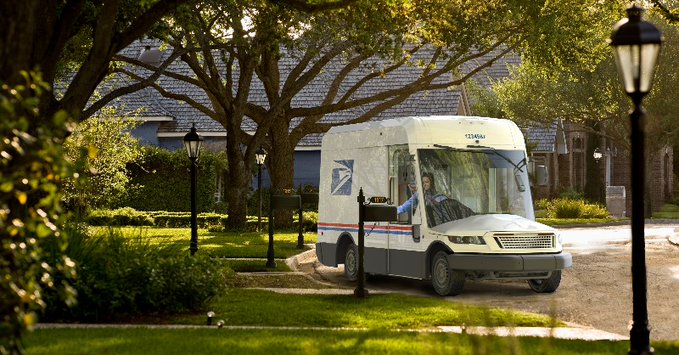The Postal Service’s Gas-guzzling New Mail Truck: Electric Versions May Be Closer Than They Appear
The sooner Congress signals—with its wallet—that the future NGDV is electric, the better.
Clean energy advocates reacted angrily last week when the U.S. Postal Service (USPS) failed to move aggressively toward electric vehicles (EVs) in awarding the long-awaited contract for its Next Generation Delivery Vehicle (NGDV). But some objects may be closer than they appear. The USPS is not anti-EV, just broke. If Congress covers the higher upfront cost of EVs, the USPS will be able to electrify its fleet at a pace that would make the Pony Express proud.
The USPS’s award of the NGDV contract, which calls for the production over ten years of 50,000 to 165,000 vehicles with “either fuel-efficient internal combustion engines or battery electric powertrains,” was the culmination of a lengthy procurement process to replace the boxy, right-hand-drive mail trucks familiar to Americans. The USPS selected Oshkosh Defense, a military contractor whose prototype delivery truck reportedly featured a gasoline engine, over two competitors whose models incorporated electric powertrains.

While the award raised concerns in the clean energy community, the implementation details that the USPS subsequently revealed were a body blow. A day after the NGDV announcement—and just weeks after President Biden called for electrifying the entire federal vehicle fleet—Postmaster General Louis DeJoy told a congressional hearing that the USPS’s current plan called for only 10 percent of the trucks purchased from Oshkosh to be electric. When asked, “Why 10 percent, why not 90 percent?,” DeJoy responded, “because we don’t have the 3 or 4 extra billion dollars…that it would take to do it.”
DeJoy’s response bore out the concern I raised in a February 10 commentary, where I cautioned that “even though a postal EV would cost far less to operate and maintain, and provide substantial societal benefits from reduced carbon emissions and accelerated industry transformation, the gas guzzler’s lower upfront price may be hard for the USPS to resist.” EV advocates panned the USPS action, and Rep. Jared Huffman (D-CA), who has led the fight to electrify the postal fleet, vowed to block the Oshkosh contract.
However, DeJoy’s follow-on comments at the hearing, which received less coverage, provided grounds for hope. First, DeJoy said he would be happy to work with the Administration and Congress “if they want to help us” with the EV commitment. His offer was a seeming nod to the House of Representatives’ 2020 infrastructure bill, which cleverly authorized $6 billion for the NGDV procurement conditional on the USPS acquiring 75 percent EVs. (The Senate failed to take up the bill.)
Second, DeJoy underscored that the USPS had spent $500 million to allow the vehicles to be converted from a conventional to an electric powertrain. Although details are sketchy, under the contract’s initial $482 million investment, Oshkosh will finalize the design of a vehicle platform—and the associated tooling and production facilities—that can accommodate an electric as well as a conventional powertrain, allowing the USPS to tailor individual orders.
In short, the USPS, which lost $9 billion last year, is negotiating, not thumbing its nose at President Biden. Given the House’s action last year, the USPS is doing exactly what one would expect: starting with a small (10 percent) commitment to EVs and inviting Congress and the Biden Administration to give it the money to increase the commitment.
It is Congress’s and the Administration’s move now. Threatening to cancel the contract is counter-productive: the procurement process has taken five years, the USPS presumably followed the rules (if not, the losing bidders can challenge the result), and it desperately needs new vehicles to replace the 30-year old legacy fleet.
Instead, Congress should give the USPS the upfront capital it needs to have Oshkosh produce EVs from the get-go. Such a one-time subsidy—conditioned on actual EV purchases—is justified given the huge environmental and innovation externalities from electrification of the giant postal fleet. Alternatively, the Administration could impose a similar condition on the $10 billion provided to the USPS in the December 2020 omnibus appropriations and stimulus bill—USPS access to which remains subject to terms set by the Treasury Department (see my earlier commentary).
Congress should move quickly. It’s too late to avoid the compromises in vehicle design that may be needed to accommodate multiple powertrains. It’s not too late to avoid the cost of maintaining two sets of fueling facilities, parts storage, mechanics, etc. The sooner Congress signals—with its wallet—that the future NGDV is electric, the better.
Longer term, Congress and the Administration need to reform federal procurement policy so that agencies award contracts based on life-cycle cost, not first cost. Clean energy technology typically costs more upfront and yields savings only over time, in the form of lower operating costs. Federal procurement can be a powerful tool for driving clean energy innovation—in federal buildings as well as the federal fleet. But this will happen only if federal purchasers recognize the true costs and benefits of their decisions.
By: Dorothy Robyn
Source: Energy Central
Next Article Previous Article
